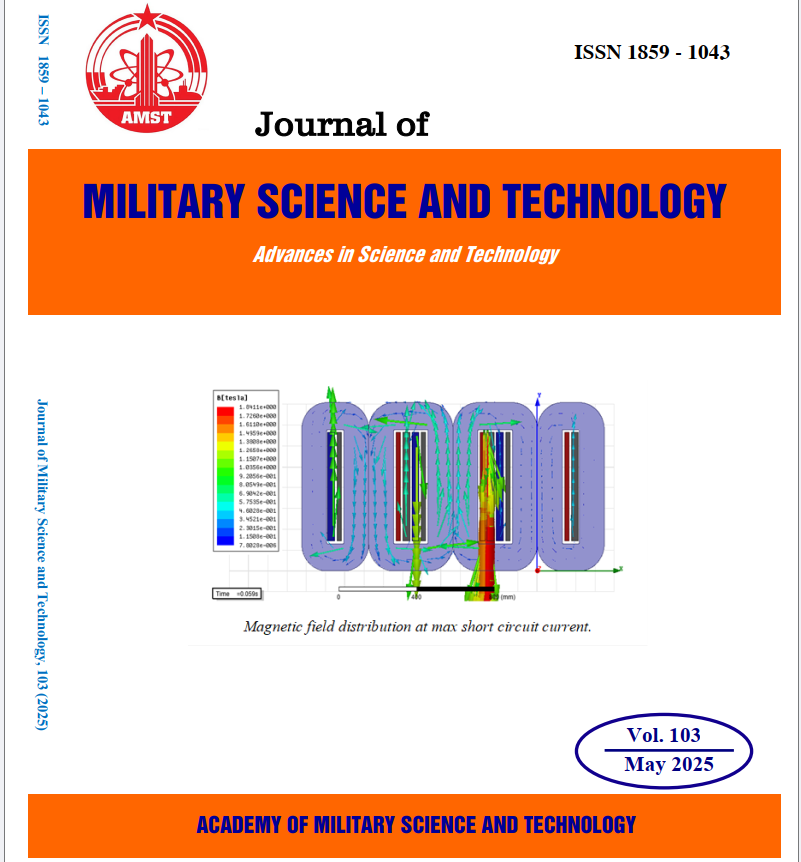High-order cumulants of wolfram metal in anharmonic EXAFS theory calculated using the correlated Einstein model
288 viewsDOI:
https://doi.org/10.54939/1859-1043.j.mst.103.2025.82-91Keywords:
high-oder EXAFS cumulants, thermal disorder, wolfram metal, classical statistics, correlated Einstein modelAbstract
The anharmonic extended X-ray absorption fine structure (EXAFS) cumulants of wolfram metal (W) in expansion to the 4th order have been calculated under the influence of thermal disorder. The temperature-dependent EXAFS cumulants were calculated explicitly and simply from a theoretical model developed based on the anharmonic effective potential and classical statistical theory within the correlated Einstein model. The thermodynamic parameters of W have been considered the influence of the nearest neighbor atoms on the backscattering and absorbing atoms. The obtained numerical results of W at temperatures from 0 to 800 K fit with those obtained from the experimental EXAFS data and the anharmonic correlated Debye (ACD) model at various temperatures. These results indicate that the present theoretical model can helpfully analyze experimental EXAFS signals of W and other similar metals.
References
[1]. C. W. Pao et al., "The new X-ray absorption fine-structure beamline with sub-second time resolution at the Taiwan Photon Source," J. Synchrotron Radiat., vol. 28, pp. 930-938, (2021). DOI: https://doi.org/10.1107/S1600577521001740
[2]. G. Dalba, P. Fornasini, M. Grazioli, "Local disorder in crystalline and amorphous germanium," Phys. Rev. B, vol. 52, no. 15, pp. 11034-11043, (1995). DOI: https://doi.org/10.1103/PhysRevB.52.11034
[3]. P. A. Lee, P. H. Citrin, P. Eisenberger, B. M. Kincaid, "Extended x-ray absorption fine structure - its strengths and limitations as a structural tool," Rev. Mod. Phys., vol. 53, pp. 769-806, (1981). DOI: https://doi.org/10.1103/RevModPhys.53.769
[4]. I. V. Pirog, T. I. Nedoseikina, "Study of effective pair potentials in cubic metals," Physica B, vol. 334, pp. 123-129, (2003). DOI: https://doi.org/10.1016/S0921-4526(03)00034-6
[5]. E. Lassner, W. D. Schubert, E. Lüderitz, H. U. Wolf, "Tungsten, Tungsten alloys, and Tungsten Compounds," Wiley-VCH, Weinheim, (2000). DOI: https://doi.org/10.1002/14356007.a27_229
[6]. K. Turrell, "Tungsten (Elements)," Benchmark Books, New York, (2004).
[7]. N. V. Hung, T. S. Tien, N. B. Duc, D. Q. Vuong, "High-order expanded XAFS Debye-Waller factors of HCP crystals based on classical anharmonic correlated Einstein model," Modern Physics Letters B, vol. 28, no. 21, p. 1450174, (2014). DOI: https://doi.org/10.1142/S0217984914501747
[8]. T. S. Tien, "Temperature-dependent EXAFS Debye-Waller factor of distorted HCP crystals," Journal of the Physical Society of Japan, vol. 91, no. 5, pp. 054703, (2022). DOI: https://doi.org/10.7566/JPSJ.91.054703
[9]. T. S. Tien et al., "High-order EXAFS cumulants of diamond crystals based on a classical anharmonic correlated Einstein model," Journal of Physics and Chemistry of Solids, vol. 134, pp. 307-312, (2019). DOI: https://doi.org/10.1016/j.jpcs.2019.06.020
[10]. N. V. Hung, T. T. Hue, H. D. Khoa, D. Q. Vuong, "Anharmonic correlated Debye model high-order expanded interatomic effective potential and Debye-Waller factors of bcc crystals," Physica B, vol. 503, pp. 174-178, (2016). DOI: https://doi.org/10.1016/j.physb.2016.09.019
[11]. G. Bunker, "Application of the ratio method of EXAFS analysis to disordered systems," Instruments and Methods in Physics Research, vol. 207, no. 3, pp. 437-444, (1983). DOI: https://doi.org/10.1016/0167-5087(83)90655-5
[12]. T. Yokoyama, K. Kobayashi, T. Ohta, A. Ugawa, "Anharmonic interatomic potentials of diatomic and linear triatomic molecules studied by extended X-ray absorption fine structure," Physical Review B, vol. 53, no. 10, pp. 6111-6122, (1996). DOI: https://doi.org/10.1103/PhysRevB.53.6111
[13]. R. Freund, R. Ingalls, E. D. Crozier, "Extended x-ray-absorption fine-structure study of copper under high pressure," Phys. Rev. B, vol. 39, no. 17, pp. 537-547, (1989). DOI: https://doi.org/10.1103/PhysRevB.39.12537
[14]. L. A. Girifalco, V. G. Weizer, "Application of the Morse potential function to cubic metals," Physical Review, vol. 114, no. 3, pp. 687-690, (1959). DOI: https://doi.org/10.1103/PhysRev.114.687
[15]. S. H. Simon, "The Oxford solid state basics," 1st ed., Oxford University Press, Oxford, (2013).
[16]. N. V. Hung, J. J. Rehr, "Anharmonic correlated Einstein-model Debye-Waller factors," Physical Review B, vol. 56, no. 1, pp. 43-46, (1997). DOI: https://doi.org/10.1103/PhysRevB.56.43
[17]. E. A. Stern, P. Livins, Z. Zhang, "Thermal vibration and melting from a local perspective," Phys. Rev. B, vol. 43, no. 11, pp. 8850-8860, (1991). DOI: https://doi.org/10.1103/PhysRevB.43.8850
[18]. N. W. Ashcroft, N. D. Mermin, "Solid state physics," 1st ed., Holt-Rinehart & Winston, New York, (1976).







